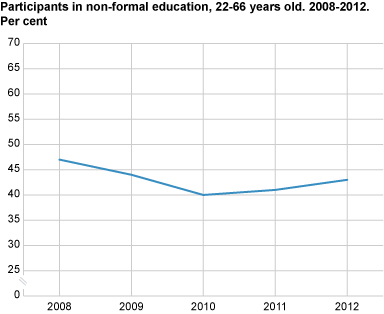Content
Published:
This is an archived release.
Higher participation rate in non-formal education among employed
About half of all employed persons participated in non-formal education during the last 12 months, compared with 14 per cent of persons not in employment. Employees in professional occupations participated the most, whereas plant and machine operators and assemblers were least likely to attend non-formal education.
Figures from the Labour Conditions Monitor (LCM) from 2008 to 2012 show that employees aged 22 to 66 were far more likely to attend non-formal education than persons in the same age group that were not employed. Female employees participated more than male employees. Persons who were employed in the industries public administration, defence and social security and financial and insurance activities had the highest rate of participation in non-formal education. Figures for 2012 show that 66 per cent of employees in the former group attended non-formal education during the last 12 months, compared with one third of persons who worked with accommodation and food service activities.
The Learning Conditions Monitor (LCM) is an annual ad hoc module to Statistic Norway’s Labour Force Survey (LFS) in the first quarter. Formal education includes all education leading to a qualification that is recognised in the equivalent of a national framework of qualifications. Non-formal education refers to any organised learning activity that is not formal education. It includes courses, seminars and conferences (where learning is the main purpose), public lectures and private lessons that are not part of formal education and guided on-the-job training. For more information, see About the statistics. |
Slight increase in participation since 2010
In 2008, about 47 per cent of 22-66 year-olds had attended non-formal education during the preceding 12 months. Two years later, the participation rate was 40 per cent, and the decline occurred both among employees and persons not in employment. The participation rate in non-formal education has increased slightly in the last two years, and was 40 per cent in 2012.
People with higher education more likely to attend
The participation rate in non-formal education varies with level of education. For those with higher education, 62 per cent of employees and 21 per cent of persons not in employment had participated in non-formal education during the last 12 months. The corresponding figures for persons with primary and lower secondary education were 37 per cent and 9 per cent respectively.
Formal education most common among the youth
Participation in formal education is most common among 22-35 year-olds, for both employees and persons not in employment. About a quarter of all employees in this age group attended formal education during the last 12 months. More than half of those aged 22 to 35 that were not employed participated in formal education. In contrast, figures for 2012 show that only five per cent of 45-59 year-olds that were not employed participated in formal education.
Tables
- Table 1 Participants in formal and non-formal education, 22-66 years old, by sex, age and labour force status. 2011-2012. Per cent
- Table 2 Participants in formal and non-formal education, 22-66 years old, by sex and industry. 2011-2012. Per cent
- Table 3 Participants in formal and non-formal education, 22-66 years old, by sex, level of education and labour force status. 2011-2012. Per cent
Additional information
The Learning Conditions Monitor (LCM) is an annual ad hoc module to Statistic Norway’s Labour Force Survey (LFS) in the first quarter. The ad hoc survey focuses mainly on participation in education.

